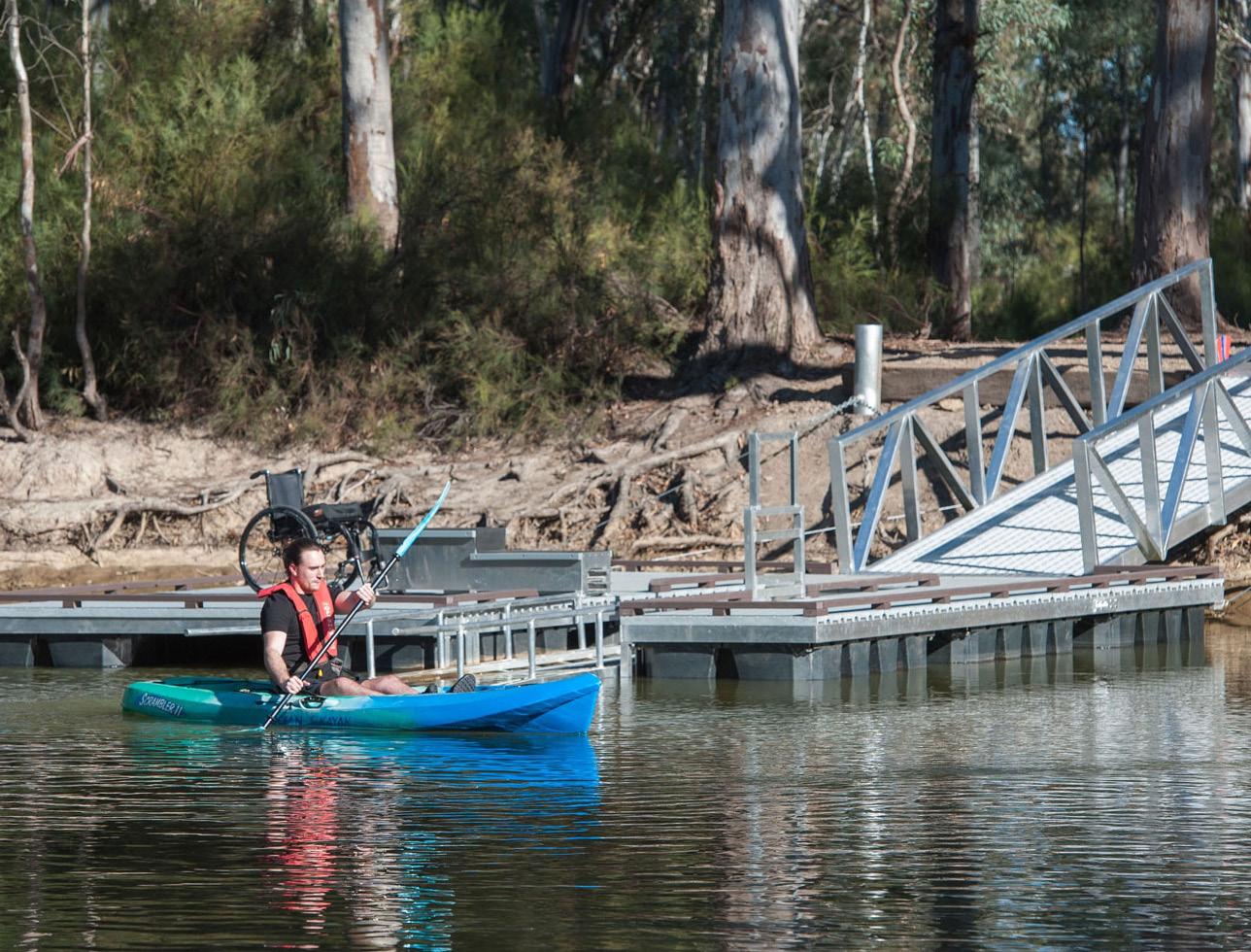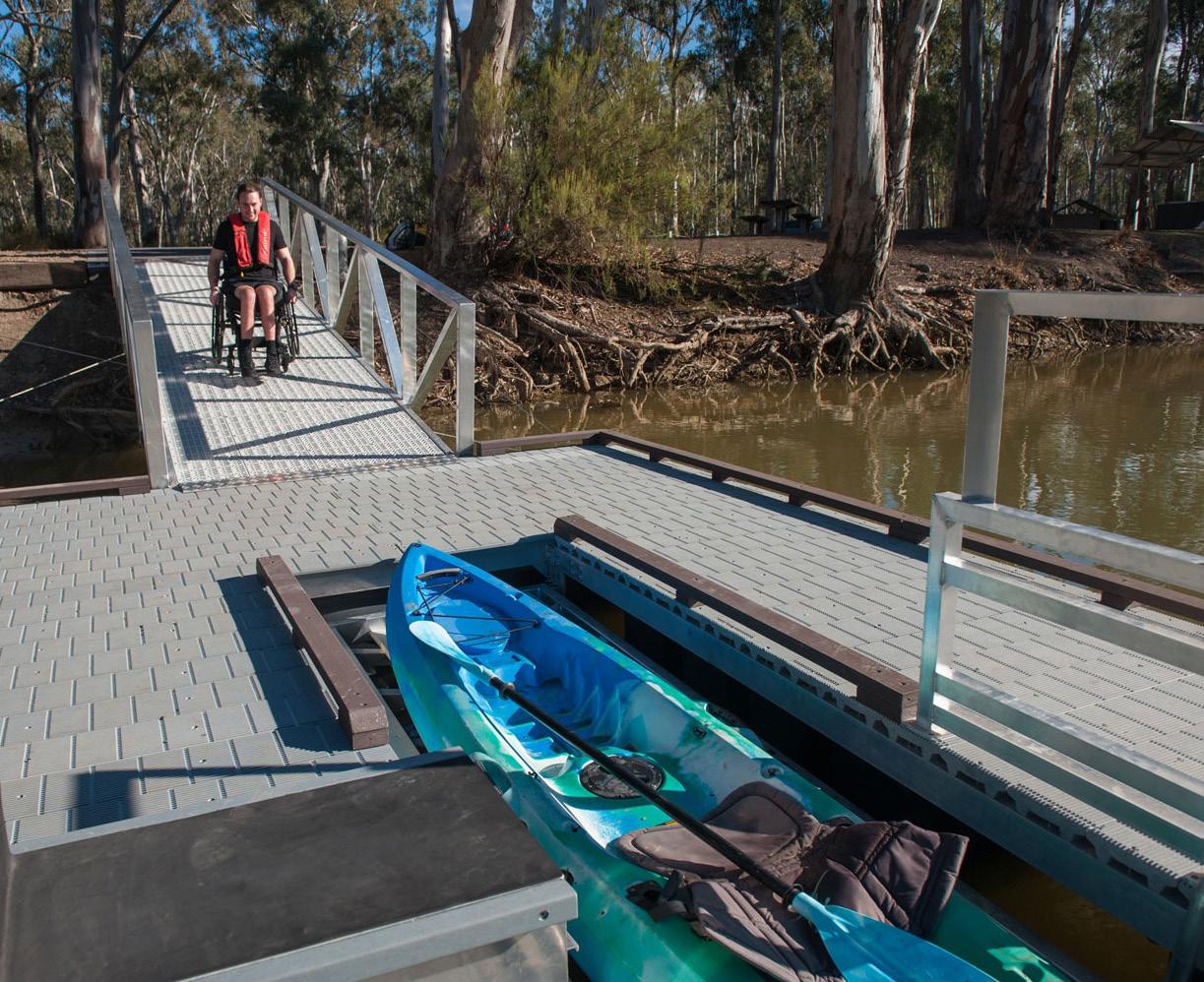
7 minute read
Access in NSW National Parks: a best practice example of Edward River Bridge’s canoe and kayak launch
Christina Bullivant (Executive Officer, Park Operations Division, NSW National Parks and Wildlife Service)
Professor Simon Darcy (UTS Business School, University of Technology Sydney)
Associate Professor Tracey J. Dickson (Canberra Business School, University of Canberra)
National parks are important places for our community; they are places to connect with nature, culture and heritage, spaces to connect with family and friends, and environments that contribute to our health and wellbeing. For an increasingly urbanised and technology-dependent society, being able to access natural areas is central for peoples’ physical and mental health. This has been highlighted by the current impact of COVID-19.
Further, a significant and growing number of people in our community have a disability, and/ or access needs, or are close to someone who does. For Australia this is 4.4million, or 17.7% of the population (ABS, 2019). Increasingly, protected area agencies, including the NSW National Parks and Wildlife Service (NPWS) are addressing accessibility in planning and managing national parks to provide enhanced accessibility for everyone including those with mobility, vision, hearing, cognitive, psychosocial et cetera et cetera disability. This means focusing not only on physical obstacles to access, but providing appropriate information, services, and assistance to support not only the visit, but also the planning and decision making that occurs prior, during and after visitation (Darcy & Dickson, 2009; Darcy et al., 2020, in print; Dickson & Darcy, 2012; Patterson et al., 2015; Smith, 2017).
Over the past decade, NPWS has undertaken a series of projects focusing on enhancing accessibility by increasing information provision, supporting physical access, and increasing people’s awareness of issues. This also includes capacity building within NPWS central and regional staff. These initiatives have, many of which are part of the Department’s Disability Inclusion Action Plan, included:
• maintaining current WCAG standards on the NPWS website
• reviewing planning guidelines and manuals to ensure that accessibility and inclusion considerations are embedded into the planning process
• delivering universal inclusion training for staff and commercial tour operators
• listing of accessible toilets on the National Public Toilet Map
• creating virtual reality footage of national parks utilising Google Trekker
• creating educational videos for teachers as part of the WilderQuest in the Classroom program
• providing mobility equipment in several locations
• creating accessibility information for hard-roofed holiday accommodation
• developing accessibility maps and information for around 50 walking tracks
• providing a searchable list of access-friendly parks and visitor experiences, and an accessible visitor website, and
• development of disability action plans.
Many of these projects have been undertaken in partnership with other organisations, including the University of Technology Sydney, University of Canberra, the National Parks Association of NSW, Google and Wild Walks amongst others.
NPWS has also focused on enhancing physical access to our parks, whereby any new installations or upgrades to existing infrastructure comply with access provisions in the disability standard on access to premises, the Australian building code, and NPWS policy and guidelines. Recent examples include the Three Sisters walk in Blue Mountains National Park at Katoomba, O’Hares Creek lookout walking track in Dharawal National Park, Wollomombi Falls in Oxley Wild Rivers National Park, and the Edward River Bridge kayak launch at Mathoura in Murray Valley Regional Park.
The Edward River Bridge canoe and kayak launch opened on 3 December 2018 at Mathoura, near Echuca in Murray Valley Regional Park. The project commenced following feedback from a local commercial tour operator concerning safety of the previous launch from the banks of the Edward River, which was very steep. NPWS partnered with SR Engineering and Replas to design and engineer a unique design wheelchair accessible multi-ability canoe and kayak launch, which is beneficial for all. The first of its kind in NSW, the launch is made from shopping bags, food and other household containers recycled by the Moama community, demonstrating both social and environmental sustainability.
NPWS has recognised the requirements of people with disability when visiting the Edward River Bridge precinct: the launch is supported by other accessible park infrastructure, including a toilet, car park, picnic bench as well as a pathway to the launch, and the NPWS visitor website also contains information and images for potential visitors to assist with decision making. This approach highlights the need to cater for whole of journey planning, from the dreaming and planning stage to the visiting stage when it comes to delivering independent, dignified and equitable accessible experiences for all types of disability and levels of support needs (Darcy, McKercher & Schweinsberg, 2020).

The local Mathoura motel had previously received some funding to upgrade two hotel rooms to provide wheelchair access. The availability of suitable accommodation complements the national park recreation offering. Without the availability of suitable accommodation, and other visitor services, such as restaurants, the decision to participate in an activity is more difficult. This highlights the need for destination planning when it comes to providing accessibility for visitors, it is not just about the one accessible visitor attraction, but the whole of the visitor’s journey, from their home to destination. This includes transport, toilets, activities and infrastructure across the whole of their journey that equate to the 3ps: can’t park, can’t pee, can’t participate!
Since its opening in 2018, the Edward River Bridge launch has received good usage, not only by those who use a wheelchair, but also by novice canoers, kayakers and older visitors. This reinforces the concept that in enhancing accessibility for people who have a disability, we are in fact enhancing whole-of-life accessibility for everyone, both for local residents and visitors alike.

In 2019 the NSW Government announced the Increasing Access to National Parks Policy, a plan to invest almost $150 million to improve access to national parks across NSW. This represents the largest investment in visitor infrastructure in NPWS’ history. The funding is divided into two streams: visitor infrastructure and facilities, and digital and safety initiatives.

The visitor infrastructure and facilities investment will enhance existing and create new visitor infrastructure, including walking tracks, lookouts, picnic facilities to make them more accessible for people to visit and use (www.nationalparks. nsw.gov.au/access-friendly). Already, projects in Sydney, the Central Coast and South Coast have been identified, and include the construction of new all-weather walking tracks, removal of stairs and barriers, re-configuration of car parks, and installation of new facilities, including toilets, to increase access for people with mobility impairments, however these upgrades will enhance accessibility for all visitors.
The digital and safety component of the program will support the development of new online and digital tools. This will include enhanced information and functionality on the NPWS website and app platforms to support users with varied abilities in accessing information to plan their visit (www.nationalparks.nsw.gov.au/accessibility). As well as the development of virtual experiences and digital storytelling, that builds on technologies like augmented reality and virtual visitation, providing an augmented experience while limiting the carbon footprint of travel.
The NSW National Parks and Wildlife Service (NPWS) is committed to providing opportunities for everyone to experience nature and is excited to deliver new opportunities via the Increasing Access to National Parks Policy over the coming years.
Given the size of the accessible tourism market , these initiatives can provide economic benefits to gateway communities (Pavkovic et al., 2017), as long as they too have suitable accessible infrastructure such as transport, accommodation and food and beverage. This highlights the need for organisations such as NPWS to partner with off-park businesses and organisations to ensure the provision of high-quality accessible recreation and tourism experiences for all.
REFERENCES
ABS. (2019). 4430.0 - Disability, aging and carers, Australia: summary of findings, 2018. Australian Bureau of Statistics. Retrieved 24 October from https://www.abs.gov.au/ausstats/ abs@.nsf/mf/4430.0
Darcy, S., & Dickson, T. J. (2009). A whole-of-life approach to tourism: The case for accessible tourism experiences. Journal of Hospitality and Tourism Management, 16(1), 24-31.
Darcy, S., McKercher, B., & Schweinsberg, S. (2020). From tourism and disability to accessible tourism: A perspective article. Tourism Review, 75 (1) pp 140-144.
Darcy, S., Ollerton, J., & Grabowski, S. (2020, in print). “Why Can’t I Play?”: Transdisciplinary Learnings for Children with Disability’s Sport Participation. Social Inclusion 8(3).
Dickson, T. J., & Darcy, S. (2012). Accessible alpine tourism project and Disabled WinterSports. In D. Buhalis, S. Darcy, & I. Ambrose (Eds.), Best Practice in Accessible Tourism: Inclusion, ageing population and tourism (pp. 339-364). Channel View.
Patterson, I., Darcy, S., & Pegg, S. (2015). Adventure recreation programming and tourism opportunities: Bringing together consumer demands and supplier understandings for people with disabilities. In R. Black & K. S. Bricker (Eds.), Adventure Programming and Travel for the 21st Century. Venture Publishing.
Pavkovic, I., Lawrie, A., Farrell, G., Huuskes, L., & Ryan, R. (2017). Inclusive tourism: economic opportunities. University of Technology Sydney Institute for Public Policy and Governance. https://apo.org.au/sites/default/ files/resource-files/2018-02/apo-nid133611.pdf
Smith, H. (2017). Naturally Accessible: Improving access through information. National Parks Association of NSW. https://drive.google.com/ file/d/1jQwK7YjUr_JAATlBbK-ommvaxSR6-bKy/ view
Photos supplied by NPWS, photos by DPIE/Rhys Leslie. Photos show the launch design, the paddler, Jason Clymo in action and the idea of independent travel.










